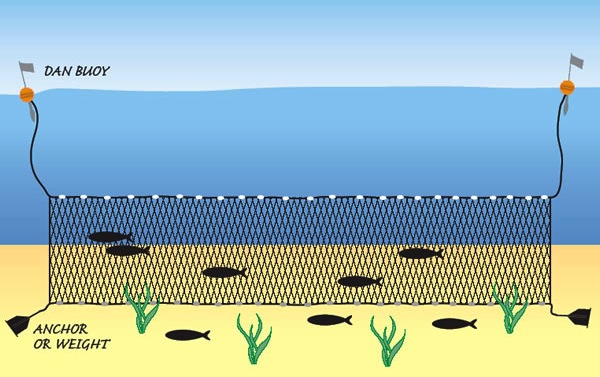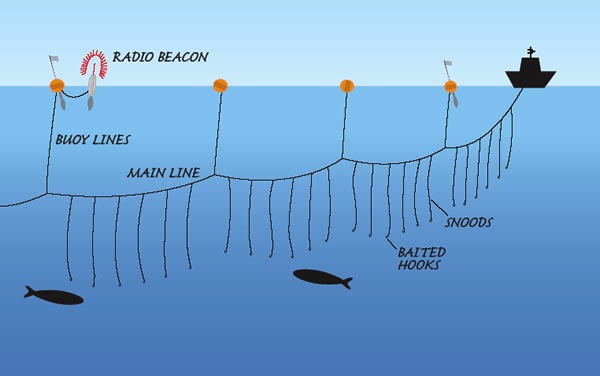Passive gears
Gillnets, entangling nets, traps and many of the hooks and lines fall under the category of passively operated fishing gears. |
|
- Gill nets and entangling nets
Gill nets are rectangular walls of netting kept erect by means of floats and sinkers and positioned in the swimming layer of the target fish, which catch the fish by holding them in the mesh by gilling.
Depending on method of operation, gill nets. Drift nets are operated in the surface layers and drift with the current either separately or with the boat to which it is tethered. Set gill nets or anchored gill nets are fixed to bottom or at a distance above bottom by means of anchors or ballast. Fixed gill nets operated in the shallow coastal waters are fixed by means of stakes and the catch is collected during low tide. Encircling gillnets are operated in the surface layers in coastal areas. After encircling the fish, noise and other vibrations are used to drive the fish towards the net so that they are either gilled or entangled.
Based on the structure there are simple gill nets with a single wall of netting supported by floats and sinkers and triple-walled nets called trammel net generally operated as bottom-set, has two outer walls which are of larger mesh size and a loosely hung inner wall of smaller mesh size. The inner wall intercepting a fish approaching through the large mesh on the outer wall, forms a pouch after passing through large mesh on the outer wall on the opposite side and hold the fish securely. In the combined gill net-trammel net, the lower part is fabricated as trammel and the upper part as simple gill net.
Entangling nets are loosely hung single or multi-walled netting held vertically in water by floats and sinkers, which catch fish entangling rather than enmeshing. Nets are usually attached end to end to form large fleets.
|
Drifit Gill Net

1. Tow rope;
2. Floats;
3. The gauge of netting is tailored to a specific size of fish;
4. Fish swim into the net and become entangled |
Bottom set gill net
 |
- Traps
Traps are passive fishing gears with enclosures to which the fish are lured or guided and from which escape is made difficult by means of labyrinths or retarding devices like funnels or constrictions. Pots are cages or baskets made from materials like wood, wicker, metal rods, wire netting and reinforced plastic, designed to catch fish, crustaceans or cephalopods by enticing them with baits or shelter spaces. They are provided with one or more entrances of appropriate gape. They are usually set on the bottom singly or in series connected by ropes and position marked by buoys.
Stationary uncovered pound net called set nets in Japan, are large nets, anchored or fixed on stakes. A leader net is kept at an appropriate angle to the swimming direction of migrating fish schools so as to guide them to enclosures with retarding devices and closed at the bottom, by netting.
Fyke net used in shallow waters consists of a ccone-shaped bag of netting with ring shaped rigid structures to maintain cylindrical shape of the net body and is provided with wings to lead the fishes into the bag. The fyke nets are fixed to the bottom by stakes or ballast and are operated separately or in the series. Stow nets are conical bag nets operated in shallow waters and estuaries where tidal currents are strong. The mouth of the net is kept open against the current by means of stakes driven to the bottom or by means of floats and ballast.
Barriers, fences, weirs and corrals are trapping enclosures made of indigenous materials and operated in tidal waters.
Aerial traps are systems in which fish like mullets, which jump out of water on disturbance and flying fishes, attracted by light are caught in floating enclosures or rafts. Verandah net and boat operated aerial traps are example in this category
|
- Hooks and lines (Passively operated)
In this gear, fish is enticed by edible bait or lure and are finally held by the hook concealed in the bait or lure. The hook is connected to a line or snood.
They are operated either singly or in large numbers.
Important types of hooks and lines which are passively operated are hand lines operated in the small-scale sector and long lines where a large number of hooks are attached to the mainline by means of branch lines.
|

Drift Long Line |
Updated on Feb 2015
|

